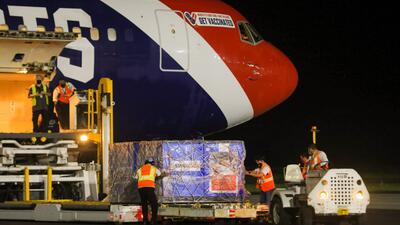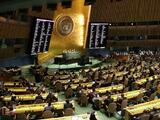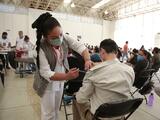Vaccine diplomacy: how the US is overtaking China and Russia

On May 21, a Boeing 767 plane landed at San Salvador airport carrying a distinctly labeled cargo of 500,000 Chinese-made Sinovac covid vaccines.
China “would always be a friend and partner” of El Salvador, said China’s ambassador, Ou Jianhong, in a clear challenge to the United States, the tiny Central American country’s traditional ally.
To add insult to injury, the plane was emblazoned with the red, white and blue logo of the six-time Super-Bowl champions, New England Patriots.
The only thing lacking were cheerleaders and a marching band.
President Nayib Bukele, who rarely misses an opportunity to poke the United States in the eye due to criticism of his authoritarian style of governing, wasted no time tweeting his gratitude to China.
Across Latin America, China has waged a successful campaign of vaccine diplomacy, using plane loads of its covid medicines as part of a global effort to increase its power and influence.
Russia also claims it has orders for its Sputnik V vaccine from about 20 countries, including Mexico, which has contracted to receive 7.4 million doses between February and April. The president and vice president of Argentina, Alberto Fernández and Cristina Fernández de Kirchner, both received jabs of Sputnik V.
But after a slow start, the United States is beginning to push back, rolling out its own vaccine distribution effort, albeit in a less self-serving, global strategy, with a lot less flag waving.
US: "an arsenal of vaccines"
Earlier this month, President Joe Biden announced his own plan to distribute 500 million Pfizer-BioNTech doses to 100 nations over the next year. Biden has promised that the United States will be “ an arsenal of vaccines for the world,” pledging $4 billion to the Covax program, a joint global effort coordinated by the World Health Organization (WHO) to deliver 2 billion covid-19 vaccines in an equitable way to poor countries by the end of 2021.
“The Chinese got a quicker start and increased the visibility of their geopolitical influence through vaccine diplomacy. Six months from now, the US will easily be the largest donator and exporter of vaccines globally ,” said Dr Krishna Udayakumar, director of the Duke Global Health Innovation Center at Duke University, which is tracking vaccine manufacturing and distribution.
The U.S. on Monday was due to begin meeting that pledge on Monday, with the first of two million vaccine doses being shipped to Peru on Monday, CNN reported.
Meanwhile, China’s vaccine diplomacy may be backfiring, some experts say, as questions are surfacing about the lower efficacy of the Chinese drugs, versus their U.S. and European competitors, such as Moderna and Pfizer-BioNTech.
Efficacy
In Chile, which has the highest vaccination rate in Latin American (48%), the president announced a third, booster dose of covid-19 vaccines may be necessary after a new wave of infections of a virus variant has raised doubts about the Sinovac vaccine which it used early on.
The Pfizer-BioNTech and Moderna vaccines have efficacy rates of more than 90 percent. A variety of other vaccines — including AstraZeneca and Johnson & Johnson — have efficacy rates of around 70 percent. The Chinese vaccines have efficacy rates of between 78 and 51%.
The New York Times found that examples from several countries - Seychelles, Chile, Bahrain and Mongolia – which indicated that the Chinese vaccines may not be very effective at preventing the spread of the virus, particularly the new variants.
Data also reveals that while China may have done a good job marketing its distribution strategy, sales have far exceeded donations. “They haven't actually delivered an enormous amount of vaccine doses through diplomacy channels,” said Udayakumar.
“They've donated a grand total of 25 million doses. So, they've largely looked at this as a market opportunity where they've been selling at fairly high price points for most of the doses that they have exported,” he added.
More sales than donations
According to a China vaccine tracker compiled by Bridge Consulting, a Beijing-based firm, China has so far sold 792 million vaccine doses, with 302 million already delivered, as of June 21.
Despite its publicity, China has in fact donated only one million vaccine doses to Latin America, including 50,000 vaccine doses to the South American Football Confederation for use in the Copa America competition.
At the same time, it has sold 291 million doses to the region, with 82 million doses deliveredion, according to the Bridge data.
To be sure, China got off to a flying start.
Early in the pandemic, while some countries, like the United States, were putting the interests of their citizens first, China and Russia moved quickly to offer vaccines to potential allies around the world.
For months during the pandemic the United States faced international criticism for hoarding vaccines – and protective medical gear and equipment - and putting the health of its citizens ahead of those of poorer countries who lack the resources to protect their own inhabitants.
Desperation
In desperation, countries like El Salvador turned to the Chinese. The first vaccines began arriving in Latin America in late January from various sources, including China (Sinovac) and Russia (Sputnik V).
Bukele
In El Salvador, China agreed to supply two million Sinovac doses, with another 150,000 that were donated, Bukele tweeted. In May, Bukele tweeted that his country had bought 4.4 million more doses from Pfizer-BioNTech.
Unlike the steady stream of Chinese publicity, the U.S. embassy in El Salvador has done far less bragging on social media about its efforts, despite being the country’s traditional ally and biggest trading partner as well as home to more than two million Salvadoran immigrants.
But that’s chiefly because its efforts have gone into the global Covax program where donations are a joint effort of numerous countries.
In fact, the first Covax shipment to El Salvador, albeit of only 33, 600 doses, arrived March 11, according to the Pan American Health Organization (PAHO), a branch of the WHO.
The U.S. Charge d’Affaires Brendan O’Brien was on hand April 20 to witness the arrival of another Covax shipment,96,000 AstraZeneca vaccines into the country.
In fact, El Salvador has so far received 12 shipments of Covid-19 vaccines: six from AstraZeneca, five from Sinovac and one from Pfizer, according to its health ministry. Six of the shipments were purchased by the government of El Salvador, five were obtained through the Covix program, and one was donated by China.
Covax strategy
Some critics say the Biden administration should adopt a more geopolitical approach to counter the Chinese propaganda machine. While the Biden administration’s decision to share 75% of its vaccine donations through Covax will help increase the number of vaccines available equitably for the most at-risk countries, it has also somewhat diluted the credit the United States receives on the ground.
In May, the U.S.-China Economic and Security Review Commission, which advises Congress, warned that the U.S. needed to begin sending its own vaccines to the region or risk losing support from longtime allies.
“The Chinese have made every delivery to an airport tarmac into a photo op,” R. Evan Ellis, a China-Latin American expert at the U.S. Army War College Strategic Studies Institute, told the panel. “The president comes out and the boxes roll off with Chinese flags on them. So, the Chinese, unfortunately, have done a much better job marketing.”
While it was important to look after the health interests of Americans first, the U.S. could not ignore the need to compete with China and Russia in the race for global influence, especially in Latin America, said Eric Farnsworth, vice president of the Council of the Americas and Americas Society in Washington.
Authoritarian advantage
“China, and Russia, made big public relations splashes to show Latin America that … they were looking out for them and would put the interests of other countries ahead of their own citizens,” said Eric Farnsworth, vice president of the Council of the Americas and Americas Society in Washington.
“You can do that if you are an authoritarian country. You can treat your citizens differently in a quest for global influence. Democracies don’t have that luxury. They have to attend to its own citizens first, which is appropriate,” he added.
While the U.S. participation in the Covax program “makes great sense if you are being a good global partner, it makes no sense at all if you are trying to compete for hearts and minds,” Farnworth argued.
Instead, he suggested the U.S. should seek to direct more Covax supplies to Latin America.
The White House says it has sought to target the Covax distribution to key U.S. neighbors. “We first made doses available to our closest neighbors – Canada and Mexico. Our dose sharing approach prioritizes Latin American and the Caribbean on a per capita basis,” Biden announced in early June.
Of the first 25 million doses, seven went to Asia and five to Africa, with another six million for South and Central America, and another batch for Mexico and Haiti. Biden said he hoped to ramp that up to 80 million by the end of June.
China pledged to join Covax early on in October 2020. That was a few months after President Donald Trump withdrew from the WHO in protest over its benign treatment of what he called “the China virus.”
In February, China’s Ministry of Foreign Affairs announced that China will provide 10 million doses to Covax, far less than the 80 million pledged by Biden. However, China has not disclosed whether these vaccines would be donated or sold, or what the delivery schedule looks like, according to Bridge Consulting.
Instead, China says it has honored its commitment to provide vaccines as a global public good by providing its own 25 million doses of bilateral vaccine assistance to countries, along with its 350 million doses in export sales.
China this month also complained about the U.S. donating two million covid vaccine doses to its democratic rival Taiwan.
"We urge the United States not to use vaccine aid as a political maneuver or for interference in China's internal affairs," China's Foreign Ministry spokesperson Zhao Lijian said at a press briefing on June 21.
Latin America in bad shape
One thing everyone agrees on is that a lot more needs to be done.
Latin America is the hardest hit in the world from the virus, with eight countries among the top 10 deadliest on a per capita basis, according to the Center for Systems Science and Engineering at Johns Hopkins University.
More than 1.2 million people have died from covid-19 in Latin America and the Caribbean while the region has suffered an unprecedented rise in poverty. Several nations are facing mounting pressure, and even violent protests in the case of Colombia, from voters outraged by the failure to control surging infection rates.
Most governments in Latin America are struggling to acquire enough doses to quickly inoculate their people, which will delay their ability to fully reopen economies.
Home to 600 million people, only 21 million doses have so far been delivered to Latin America as of June 23, according to PAHO.
Officials at the World Health Organization last week repeated their calls for the world’s governments to accelerate plans to distribute coronavirus vaccines to hard-hit nations, warning that many countries in Latin America continued to see rising caseloads.
“Only one in ten people have been vaccinated against covid-19 in the region, where “hospitals are full, variants are rapidly circulating,” and “vaccines are urgently needed today,” PAHO’s director Dr. Carissa F. Etienne, said.
Etienne singled out the vaccine shortage in Central America, home to more than 44 million people, where only 2.4 million have been fully inoculated. In Honduras, barely 0.5% haven vaccinated, while in Costa Rica, which has the best performance, is still only 14.4%.
Fewer than three million people have been vaccinated in nations in the Caribbean, which has a population of just over 34 million.
South America is only slightly better with only 10% in Brazil, 8% in Argentina, and 7.5% in Colombia. The exceptions are Chile (48%) Uruguay (38%).
Etienne said that only a more equitable distribution system would put an end to the pandemic in the foreseeable future.
“Today we’re seeing the emergence of two worlds, one quickly returning to normal and another where recovery remains a distant future,” Dr. Etienne said. “Unfortunately, vaccine supply is concentrated in a few nations while most of the world waits for doses to trickle down.”



